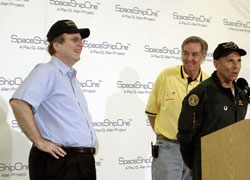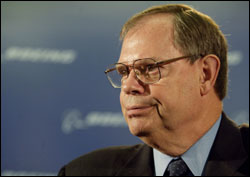Paul Allen gets a lot of grief for being a billionaire who is not Wall Street–smart, for being a nerd, for getting the taxpayers to build him a football stadium, for buying up a neighborhood and flooding City Hall with lobbyists to get a trolley-car line and street improvements, for hiring Frank Gehry to design the Experience Music Project building, for owning the Portland Jail Blazers, for being the lesser co-founder of Microsoft, for not being Bill Gates. Allen is not an embrace-and-extend kind of guy. In the years since he left Microsoft in 1983, through his Vulcan holding company, Allen boldly invested where no one had before. He threw money at a lot of cool ideas, starting technology and Internet-content companies and backing products that were fantastic and fun, but lacked a present-day business model. He hasn’t had a sure thing since he and Gates licensed an embraced-and-extended operating system to IBM in 1980. BusinessWeek recently reported that Allen’s fortune has shrunk from a peak of about $30 billion five years ago to something south of $20 billion today. What a chump.
Besides committing the capitalist crime of daring to invest in unsure things, Allen has tried to share his hobbies with us. Sometimes it’s overdone, like EMP. His plan for a biotech-anchored urban village in the South Lake Union neighborhood is visionary, but its execution has been politically heavy-handed, and any public investment in his faith in biotech’s future here is a gamble. For all his shyness, Paul Allen is in our face, in our space.
But there aren’t too many billionaires who aren’t, and it’s not as though no one else lost a third of their investment equity when the bubble burst, that nobody else bought into dreams that were cool and seemed promising, that ought to have panned out but didn’t. Allen has invested with imagination and heart, and he’s paid for it. So did I, and so did a lot of other people. To borrow a term from the engineering world, dumb investing is scalable.
Dreams are scalable, too, and sometimes the most wonderful ones are modest. KEXP-FM, for example, the radio station that Allen backs through EMP, has redefined public broadcasting by embracing emerging and marginalized music. Chump change for a billionaire, but an exponential, widely shared cultural pay-off. The new Science Fiction Museum and Hall of Fame that opened last week, a delightfully cluttered collection of cool stuff tucked inside a corner of architecturally hideous EMP, is a similar contribution to the collective consciousness of a creative and often influential niche. It cost Allen $20 million.
And now there’s SpaceShipOne. Allen’s investment in Mojave Aerospace— ironically, about what it cost to launch the Sci-Fi Museum—is relatively nothing, and yet, to legendary aviation innovator Burt Rutan and test-pilot-turned-astronaut Mike Melvill, that $20 million was huge. On Monday, June 21, Melvill, 63, flew an airplane into space above California— to 328,491 feet, which is 100 kilometers, or 62 miles—to become the world’s first private-sector astronaut. As Rutan put it before the flight, Allen’s cash for the joint venture enabled a team of two dozen people to create a space program from scratch in three years. Rutan thinks the payoff could be huge for humankind. It could be huge for Allen. Two words: intellectual property. Chump, indeed.
This story of Allen doing more with less is unfolding in the Mojave Desert. The town of Mojave, Calif., and its airport aren’t much to look at. In fact, the whole area seems to be stuck in the past and obsessed with the future, without much regard for the present, except for fast food. Nearby Edwards Air Force Base, on the famous dry lake bed where now-well-known test pilots like Chuck Yeager toiled in obscurity at the dawn of the jet age, and where NASA’s space shuttle often landed, is sacred ground. Mojave’s airport, a Marine air base back in the day, evolved into a little-known civilian test-flight center. It’s where Rutan and his brother, Dick, developed Voyager. Dick and Jeana Yeager flew the ungainly, carbon-composite, white propeller plane around the world in 1986, beginning and ending at Edwards—without refueling. It took them nine days. As if in tribute, all around on the nearby brown hills are hundreds of giant, white, spinning propellers—electricity-generating windmills marking time until a future of clean energy. But the oddest thing about Mojave Airport is the 150-odd jetliners parked in clusters around the field, in various states of preservation and disassembly. The blown-dry desert is friendly to aging metal, and who knows, some Third World airline might need a slightly used, 30-year-old Airbus A300, McDonnell Douglas DC-10, or Boeing 747. These hulks of Toulouse, Long Beach, and Everett marked Monday’s airplane ride to space with silence, their windows and engines covered—against the desert dust but as if they couldn’t stand to watch. The Washington Post called the Mojave Airport ramshackle, but it was a magical place for Rutan, Allen, and Melvill to barnstorm—to suggest a future of affordable space flight, an alternative to the bloated, paralyzed- by-fear bureaucracy of NASA. They did this just after dawn.

History gets off the ground: White Knight carries SpaceShipOne. |
While Rutan and Allen were hunkered down in a mission-control room at an airport hangar, Melvill rode in SpaceShipOne as it was lazily carried aloft to about 50,000 feet by a mother ship called White Knight. Below, thousands of spectators and 550 journalists—one whose name you might recognize called it “the biggest cluster-fuck I’ve seen in 10 years”—craned their necks. Dozens of TV channels and networks were doing live shots for the morning news. It was an air-show-like carnival so beautifully made for video that Vulcan, which coordinated PR, had planned to have only a Discovery Channel documentary crew chronicle the flight on video, forgetting to organize a pool for still photographers. (That was hastily remedied.) Rutan had announced the date of the space shot just a couple of weeks earlier, but despite the short notice, the media had turned out in force. Until the announcement, SpaceShipOne had been largely below the radar. It was only last December that Allen revealed his role as angel investor. Obscure, too, have been the efforts of 25 other teams around the world that are competing for the X Prize: Ten million dollars, put up by private investors, goes to the first team to complete two space flights with the same craft in a two-week period, carrying a pilot and two passengers or their equivalent weight. Rocket, plane, launched from the ground, launched from water, launched from a balloon, launched from another plane—all these ideas are on drawing boards around the world. Only Rutan has even been close to trying it, though. Suddenly, Monday morning, there was a new space race. The media were covering it like it was 1961, and Allen and Rutan and Melvill were the stars.
When White Knight, carrying SpaceShipOne, taxied by the throng before takeoff, it looked like some kind of Buck Rogers contraption. The mated fuselages of the two planes were identically shaped, with small round windows wrapped around their noses—classic sci-fi-movie rocket design. Or maybe two joined aerobatic planes ready to do stunts between heats at the Seafair hydroplane races. Allen had nothing to do with the design, but it sure looked like something from his childhood. A scale model could hang in a Sci-Fi Museum display case and no one would think twice. “Model used for opening credits of film SpaceShipOne, 1957.” In Allen’s new reality, which back home included Capt. Kirk’s chair and the police car from Blade Runner, it was hard to tell where Hollywood science fiction ended and factuality began. On the backdrop at the press conferences this week, there was a repetitive logo that said, “SpaceShipOne, a Paul G. Allen Project.” In case we thought it might be “a Spike Lee Joint.”
When they reached 50,000 feet, no one could see White Knight and SpaceShipOne, way out east, just under the rising sun. They could have been faking it, for all we could tell. Then White Knight turned on air-show smoke, and we could see a speck, and through binoculars we could see SpaceShipOne drop, and then a barely discernable flame, and then—holy shit—a trail of smoke straight up, zooming past the sun and into the deepest blue right above us. In a little over a minute, this smoke trail rose from no more than 45 degrees above the horizon to 90 degrees. I think that’s when it sank in for everyone. This was serious. He’s way the hell up there. When the plane’s rocket engine stopped, so did the smoke, and we lost track of SpaceShipOne until it was nearly back at Mojave Airport, gliding in for the landing. There were cheers, even among the been-there-seen-that members of the media.
On Sunday, at the preflight news conference, the personalities were distinct. Allen was proud but pensive, quiet, rarely volunteered comment. He wore a blue, open-collar dress shirt and dark dress pants. Rutan wore denim. He was folksy, talkative, confident, competitive, but humble and respectful. Though he called him “Paul,” Rutan also referred to Allen as “our customer.” Before and after the flight, Rutan and Melvill were effusive in their gratitude to Allen. You can imagine how exciting it must have been to have a billionaire walk into their little world in Mojave three years ago. But Allen was nervous before the mission. What if he had bankrolled a spectacular failure? It wasn’t until after the flight that Allen cracked a smile. He remained thoughtful in celebration, nodding when Rutan or Melvill delved into the technical fine points—he knew this stuff. He was invested.

Melvill: the world’s first private astronaut. |
Speaking of which, where is this investment heading? There isn’t consensus in the aviation world. Before the flight, Space.com posted an interesting article that looked at the future of private space flight skeptically, with experts noting that reaching orbit, to name one logical next achievement, is a whole other matter. Some suggested this would be a fun stunt but wouldn’t lead to much. But they don’t know what Rutan and Allen and their team know. Rutan waxes lyrical about the possibilities. In 1908, he said, when only 10 people in the world had flown, no one knew what airplanes were for. Then Wilbur Wright went to Paris to show the Europeans he wasn’t lying. “They watched him do turns, and they watched him fly for long times, and they watched him do multiple flights a day,” Rutan said, “and I believe that the significant thing is they all said at the same time, ‘That’s something that I can do, because these guys are just bicycle shop guys.'” Within years, there were thousands of pilots. Their barnstorming led to carrying mail and passengers and fighting wars.
In the case of private space flight, Rutan said, “I believe that realization will attract investment, that realization will attract a whole bunch of activity, and very soon, it will be affordable for you to fly” into space. “I think you don’t start a new industry by defining first what the applications are. I think you go out and take some risks and determine what capabilities are possible and the applications come later.”
As for what’s next, Allen and Rutan ain’t talking. “Our company in general doesn’t go to these engineering symposia and brag about what we do, just because it’s teaching our competitors,” Rutan said. “A lot of things we’ve learned on this, particularly things that we’re going to move into . . . ” He caught himself. “Particularly things that we might move into—larger suborbital or orbital craft—those are intellectual properties that are owned by Mr. Allen and us.” At another point, Rutan said, “We’re heading to orbit sooner than you think.”
Though conversant in the technicalities, Allen is also emotionally invested in SpaceShipOne—still listening to his gut. “I saw one of the first shuttle launches back when we were doing the initial software for the IBM PC,” he said at the postflight news conference. “These things bring your heart right into your throat, whether you’re there as a spectator or you’re a participant, and I’m just happy to be part of this to try to move things forward in the area of private space travel.”
If it all comes true, there’s maybe only one thing in Allen’s long-shot portfolio that could upstage his space program. Call it another frivolous, eccentric hobby if you like, but try to imagine the future after success at another obscure Paul G. Allen project, involving radio telescopes and thousands of PCs. The government stopped funding it years ago, and he stepped in. SETI, it’s called. The Search for Extraterrestrial Intelligence.







